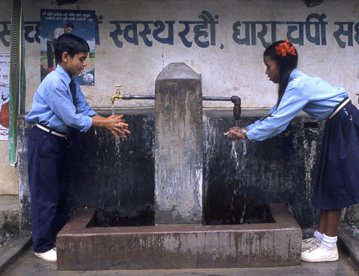
Sanitation is considered as fundamental human rights of human being as well as the identification and the process of life of the civilized citizens. Human development and dignified lives are possible only with access to safe drinking water, adequate sanitation and improved hygiene. Due to the lack of adequate sanitation there will be adverse impact on health, education and working environment which leads to the adverse effect to entire development of human beings. There is close relationship between healthy life style of the human beings and sanitation and sanitation plays a vital role to develop the self esteem and prestigious life of human beings in the society.
Although Nepal has the poorest functional drinking water and sanitation coverage for its population in South Asia, Nepal Government has made the commitment to have the universal coverage of drinking water and sanitation by 2017 and to increase the access of sanitation facilities up to 53 percent by the year 2015. But if we analyze the present statistics only 62 percent of the Nepalese people have access to the sanitation facilities. This means each day more then 10 million people defecated openly in Nepal. Every year in Nepal, 10,500 children under the age of five die due to sanitation and drinking water related diseases, more than half of which are girls.
School is the first step of socialization and development of a child. After admitted in the school a child needs the facilities of sanitation and hygiene as equal as the quality education and child friendly environment for the entire development. School determines the entire behavior of the children and new hygiene and sanitation behavior learned at school can lead to life-long positive habits of the children and which may positive influence for family and entire community.
Although water and sanitation facilities in schools is fundamental for promoting good hygiene behavior and children's well-being, but the situation is quite different. According to the statistics among 28 thousands community school only 18 thousands schools have toilet facilities. But the coverage of functional toilet is very low in community schools. The number of the school which has the separate toilet to the girls' students is only 20 percent. If we see the situation of toilet of private school, there are no appropriate toilets in those schools.
According to the education regulation of Nepal a toilet has to serve at most 50 students i.e. ratio of the toilet to student is equal to 1:50. But in reality a school has been serving 127 students in an average, which is more than two times than the standard set by the government. In some of the schools more than thousands students are forced to use even a single toilet.
The burden of not having sustainable and effective sanitation system falls most heavily on girls. Due to the lack of inadequate sanitation facility in the school for girls students, dropout rate among adolescent is high, so girls are denied from education. Due to the lack of toilet facilities students are forced not to drink enough water which caused the increase numbers of diseases. Due to the lack of proper toilet facilities in the school most of the students are compelled to defecate in open spaces and are exposed to severe health hazard risks as well as seen as the pollutants of environmental sanitation.
Current research shows that the economic returns on successful sanitation projects are very high, both on a macroeconomic level and a project/household level. It is calculated that the return from the sanitation sector is nine times more the investment. Similarly proper hand washing in the critical time may reduce 45 percent of diarrheal diseases and the proper education of hygiene can reduce 36 percent of harmful disease. So it's essential to think and act about this.
Despite this situation, this sector is being neglected. There are many reasons behind the situation. The main reason for this is lack of coordination between concerned stakeholders and lack of monitoring. Similarly lack of awareness to the parents and students and carelessness also leads to this situation. So there should be strong coordination among sector stakeholders and the parents should create the pressure for the construction and use of safe and hygienic toilet. It is equally important to monitor the situation of sanitation and hygiene from the government line agencies and parents themselves. Similarly it is equally important to conduct sanitation and hygiene promotion program at the school and community level.
Every child has a right to sanitation and hygiene. Lack of adequate sanitation facilities has a negative impact on education, health, dignity, security and economic growth. In this regard it is essential to increase in the allocation of budget for toilet construction in school and to promotion of sanitation in hygiene and to contribute to the national target of the government of Nepal. So all of the concerned stakeholders should sensitize and ignite in this matter. So its time to think and act in this matter and to bring the issue of sanitation and hygiene at the main stream of development.













